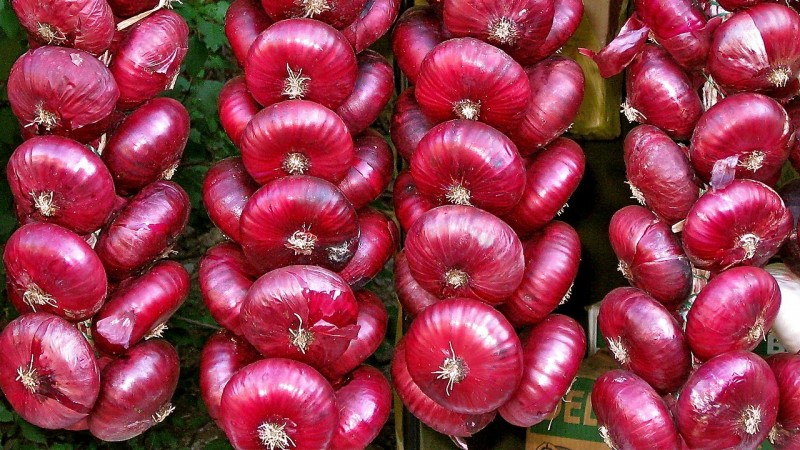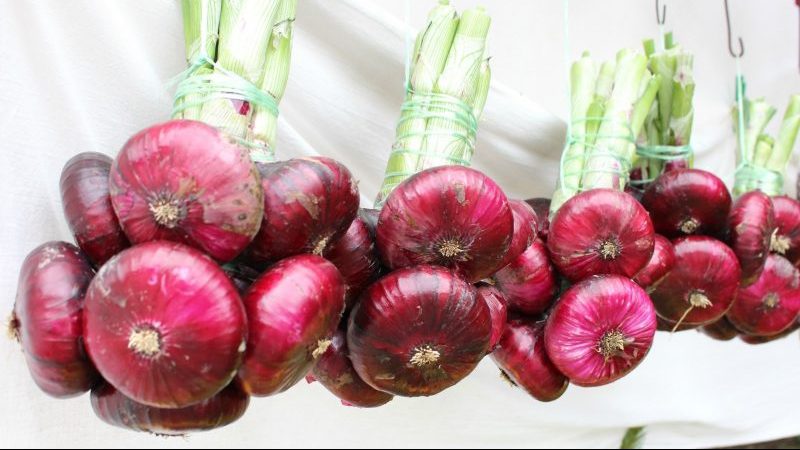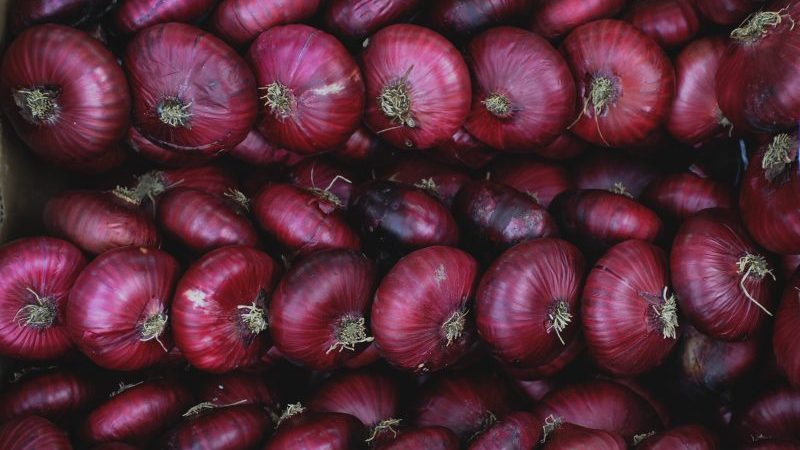Why is Yalta onion so good and how to distinguish it from a fake
Yalta onion is a popular vegetable among gourmets. It has a milder taste and less pronounced aroma than varieties from other regions, does not cause watery eyes, is suitable for making salads, side dishes, and real craftsmen even make jam from it.
The content of the article
Why is Yalta onion so good
Yalta, or Crimean, onion, like most other onions, is a biennial. The homeland of the famous sweet vegetable is the village of Zaprudnoye, located along the highway on the southern coast of Crimea. The onion is recognizable for its purple color and pleasant sweetish taste. It is recommended to be included in the diet to strengthen immunity, protect against infections and viruses. It is also allowed in the diet menu.

general characteristics
In order for a vegetable to grow with pronounced properties inherent only to it, a special climate and weather conditions are required. Clay or slate soil is suitable for him. About 100 tons of Yalta onions are grown in the whole of Russia now, so experts say that it is impossible to buy it anywhere other than Crimea.
The Crimean turnips grow dense and large feathers, in appearance they look waxy. On average, one specimen weighs up to 150 g, and the arrows reach 120 cm. The greenery of the plant is formed for a very long time, therefore it is grown only with the help of seedlings. The total ripening period is about 150 days.
Reference. In the Yalta onion variety, scales are difficult to separate. If it turns out to be easy to separate with your hands, then this is a fake - an ordinary variety tinted with manganese.
For storage the vegetable is not good because it contains a lot of water and sugar. However, it has beneficial properties, contains many essential oils, vitamins, antioxidants.
Crimean bow:
- activates the useful amino acid in the body - cysteine, which promotes the elimination of toxins and synthesizes collagen;
- reduces harmful cholesterol, improves the functioning of the cardiovascular system;
- increases the level of acidity of the stomach, activating the digestive processes;
- has an antitumor effect due to the content of allicin;
- acts as an anthelmintic.
Experts advise the vegetable to those who have problems with potency, suffer from frequent colds and other ENT diseases. The optimal daily amount is 100 g, otherwise an allergic reaction may occur.

Where grows
This vegetable is grown only on the southern coast of the peninsula. It is considered one of the visiting cards of Crimea. Together with other sights in the form of shells, grapes, wine and exotic fruits, Yalta onions are sent to different regions in whole bundles. However, it is quite difficult to buy an original product.
Onions are grown in accordance with all technologies in the villages of Lavrovoe and Zaprudnoye. The settlements are located a few kilometers from Alushta, the village of Pushkino, where you can get by moving along the Yalta - Simferopol highway. Also in recent years, crops have been harvested in the Blue Bay and with. Landslide, not far from the famous resort Simeiz.
This culture was brought to the territory of Crimea from the island of Madeira in the Atlantic Ocean. Initially, they tried to domesticate it in the Botanical Garden in Nikita, but the most suitable areas were only two small villages.
Distinctive features
In order not to really make a mistake when buying, taste the onion - it is sweet and mild. However, not every seller is allowed to do this.
The Crimean bow is recognized by its characteristic features:
- lack of a pungent odor;
- bright red or purple hue of scales;
- medium-sized fruits;
- slightly flattened onion;
- slightly retracted root part;
- varnished head, while fakes have a matte skin.
Internal plates have a thickness of no more than 6-7 mm, there are up to 7 of them.
How to distinguish Yalta onions from fakes
The counterfeit is immediately recognized by its taste. It lacks the characteristic sweetness. Peeling Yalta onions does not irritate the mucous membranes of the eyes and nose, as it does not have a pronounced pungent odor.

How to choose the right one when buying
When buying vegetables from the market, lightly pry the skins. If there is no pronounced onion smell, then this is a Crimean variety. On the cut, the layers have a pale pink color.
The vegetable has a short shelf life. It ripens in mid or late July: buy only during this period. On the roads of the Crimea, buyers are often deceived by offering ordinary turnips, tinted when grown with special preparations.
Reference. The soils of Yalta, where the Crimean onion grows, contains a large amount of Tauride shale. This material accumulates heat during a sunny day and then prevents the soil from cooling down at night. This is one of the main factors that determine the specific taste of the bulbs.
Key features
It is difficult for an inexperienced buyer to determine whether a fake or a real Yalta onion is on the counter. However, some signs will tell you exactly whether the item is worth purchasing.
Differences in appearance
The main feature of the variety is the bright purple color of the turnips. Unlike other varieties of onions, Yalta has a flat, slightly rounded and large shape. It has much thicker inner layers than the rest of the bulbs. They also have purple piping. The rind is firm and thick.
Reference. In ancient Egypt, it was believed that onions were a powerful aphrodisiac. Therefore, the priests were forbidden to eat it, and the newlyweds were offered the product in the morning after the wedding night.
Difference in taste and smell
By itself, the Crimean onion is devoid of sharpness, bitterness and a strong smell, therefore, in salads and other dishes, it does not interrupt the taste of other components. After it use no need to worry about bad breath. It is a juicy and satisfying product that will leave only a slight characteristic aftertaste.
In order to preserve the maximum amount of nutrients and vitamins in vegetables, it is not recommended to heat them. After the first five minutes of cooking or frying, the complex of valuable substances, including vitamin C, is almost completely destroyed.
Features of growing Yalta onions
To grow a high-quality crop with characteristic taste properties, special climatic conditions are required. However, some gardeners are trying to grow at least a few heads on their site in different regions.
Landing
Crimean bow is obtained only from seed... Preparations begin in mid-February. Use wooden or plastic containers filled with a suitable substrate:
- sod land;
- humus;
- mineral fertilizers (70-80 g).
The planting material is sent into a soil layer with a thickness of at least 15 cm, it is pre-soaked for 20-22 hours to increase germination. After wet processing, the seeds are dried.
Grooves are formed in the ground, seeds are placed at a distance of at least 1 cm from each other. Sprinkle everything on top with humus and tamp it slightly. The top layer is a little fine sand. Containers with seedlings are covered with polyethylene and left in a ventilated room at a temperature not lower than + 20 ° C. The first seedlings should appear in 6-8 days.
After the formation of the 4th leaf, a pick is required.The seedlings are removed from the container, the root part and leaves are slightly shortened. After that, the plants are sent to open ground. Choose an area lit by the sun, without drafts and with a sufficient amount of nutrients.
Important! When planting, consider the rules of crop rotation. Yalta onions are planted in areas where white cabbage and greens, potatoes and tomatoes grew. Soils are not suitable after any varieties of onions.
Care
Yalta onion needs constant loosening of the soil, weeding and regular watering. The soil is irrigated once every 5-6 days, taking into account climatic and weather conditions. 1 m² requires 20-30 liters of water with a temperature not lower than + 22 ° C. The most optimal wetting method is along the grooves instead of sprinkling. This will prevent fungal infections and mold.
When weeds appear, the beds are weeded. For active development, the culture is fed. Fertilizers are applied at intervals of 10-12 days after planting in open ground.
Use:
- a solution of 5 liters of water, 3 g of potassium chloride, 10 g of superphosphate and 5 g of urea;
- 100 g of yeast, diluted in 10 liters of water;
- chicken droppings with water in a ratio of 1:10.
Excess fertilization, as well as insufficient, is harmful to the plant and will affect its growth and taste.
Watering is stopped 3 weeks before the planned harvest. This will allow the turnips to form normally, they will not come out watery.
Disease and pest control
Crimean onions are characterized by resistance to diseases and pests. Most often, a threat to the crop occurs when there is an excess of moisture in the soil or improper watering. The root part of the plant rots, and then the turnip also deteriorates.
Sometimes gardeners are faced with peronosporosis - a fungal disease that quickly affects large areas of plots.
For prevention use:
- 1% solution of Bordeaux liquid - after rooting of seedlings in the open field;
- 4% Arcerida solution - 20-21 days after the first treatment;
- repeated application of "Arcerida" after another 20 days.
With all agrotechnical work and proper care, the risk of developing diseases is minimal. The plant tolerates unfavorable weather well, however, at the slightest damage to the turnips, pathogens enter them. The presence of pests on the site is evidenced by drooping tops, growth retardation.
One of the most unwanted guests is the onion fly. An adult insect is not dangerous. The eggs and larvae laid by him pose a threat, which destroy almost half of the bulb. Thrips, the onion moth, and the lurker are also widespread.
For prevention, special complex drugs and folk remedies are used:
- sprinkling the beds with tobacco dust;
- dispersion of ground red pepper on the site;
- sprinkling with crushed wood ash.
It is advisable to plant carrots or garlic in the neighborhood. These crops scare off pests with a specific smell.
Collection, storage and use of the crop

A characteristic feature of the Crimean onion is its ripening by mid or late July. It was at this time that numerous bundles of vegetables appeared on the roads of the Crimea, offered to tourists.
The variety is not suitable for long-term storage. The maximum possible shelf life of it at a humidity of up to 50% and a temperature of + 15 ° C is up to 2 months. It is advisable to consume this product immediately after cultivation or purchase, while useful substances are still preserved in it. A convenient way of storage is in bundles. A vegetable folded in layers or in bulk spoils quickly.
Conclusion
Yalta onions are added to vegetable salads, meat pickles, and used in chopped slices. This delicacy does not require additional spices, as it has a unique taste.
The southern Crimean coast is best suited for growing Yalta onions, but many gardeners make every effort to get crops in their beds in other regions of Russia.To do this, take into account the rules of planting and care, provide suitable growth conditions and choose high-quality seed.